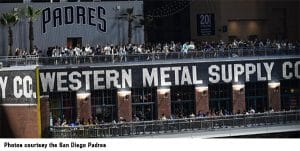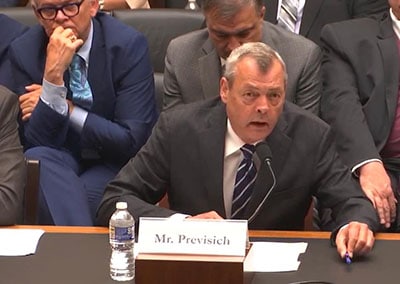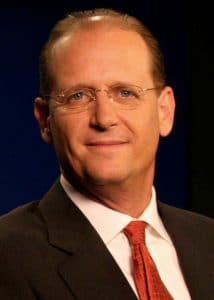A Florida judge has dismissed a lawsuit that three CSX shareholders had filed last summer against the carrier regarding the 2017 hiring of late CEO E. Hunter Harrison.
The matter was settled by Virginia state law, which required that the suit be dismissed after a committee of “disinterested” CSX board members determined that the suit, which involved the company suing itself, should not go forward.
The shareholders who filed the lawsuit, John Robertson, James Ekis and George Triefenbach, have the option of filing an amended derivative complaint 30 days after the June 3 dismissal by Judge Kevin Blasz of Florida’s Fourth Judicial Circuit Court.
For more background, see this previous story.
Author: bnagy
Ohio State Legislative Director Stu Gardner requests that members from his state show their support for H.B. 186, a comprehensive rail safety bill that is receiving its first hearing in the Ohio Legislature on Tuesday, June 18.
Ohio Reps. Brent Hillyer and Michael Sheehy, who is a retired SMART TD member and a member of the TD Alumni Association, will introduce the bill at 11 a.m. to the House Transportation Committee in Room 114 at the statehouse in Columbus.
The bill covers:
- Two-person freight train crews
- Common-sense safe walkways within rail yards
- Common-sense illumination of rail yards
- Blocked crossings that obstruct and delays emergency vehicles
“An overwhelming show of support is our goal,” Gardner said. “Show those members of the Transportation Committee that we care and are serious about our safety, and the safety of the communities the we work in and pass through.”
Here’s a quick update on where legislation important to SMART Transportation Division members stands on a national level:
The Safe Freight Act in the U.S. House (H.R. 1748), national two-person crew legislation introduced by U.S. Rep. Don Young in March, has 60 co-sponsors consisting of 56 Democrats and 4 Republicans. It has been referred to the House’s Subcommittee on Railroads, Pipelines, and Hazardous Materials.
The Transit Worker and Pedestrian Protection Act has versions in both the U.S. House (H.R. 1139) and in the U.S. Senate (S. 436). It is intended to protect bus and transit operators from assault through various strategies and requires that both rail and bus transit agencies (those not covered by the FRA) create risk-reduction plans to protect operators and that the agencies submit those plans to the U.S. Department of Transportation (DOT) for approval. The Senate version has 13 co-sponsors since its introduction in February, while the House version has 145 co-sponsors since its February introduction. The Senate version has been referred to the Committee on Banking, Housing, and Urban Affairs, while the House version has been referred to the Subcommittee on Highways and Transit.
The Railroad Yardmaster Protection Act of 2019 (H.R. 2449), which covers yardmaster hours of service, was introduced in early May and has two co-sponsors. It has been referred to the House Subcommittee on Railroads, Pipelines, and Hazardous Materials.
Remember that your elected officials need to hear from you about these issues that matter to your safety in the workplace. An easy way to do this is by emailing your legislators through the SMART TD Legislative Action Center, but phone calls and face-to-face meetings help drive the point home even more.
Open enrollment has begun for SMART Transportation Division bus and rail members in the union’s new Voluntary Disability Plan (VDP). The plan, now underwritten by Amalgamated Life Insurance Company, is available for long-term protection against a sudden loss of income due to an illness or injury. Although Open Enrollment will run through Nov. 30, 2019, members may sign up at any time during the enrollment period. Coverage will commence upon successful completion of the enrollment process.
This plan has been established to provide yet another level of financial security to members in the event that a long-term recovery from an illness or injury leaves them unable to work. Members can customize their 24-7 coverage by selecting the benefit option best suiting their individual needs and then pay for coverage through payroll deductions. VDP benefits are payable after a 180-day elimination period and are paid in addition to any other benefits such as the TD Voluntary Short-Term Disability (VSTD) plan, worker’s comp, Railroad Retirement Board (RRB) sickness benefit or others.
The new VDP has two- and five-year options with monthly benefits starting at $300 up to $5,000 available in $100 increments that can cover up to 60% of an enrollee’s earnings. Approval of benefits from Amalgamated is subject to participation requirements and/or simplified medical underwriting.
This VDP coverage is portable for all members, and it won’t be lost if an enrollee is furloughed or suspended. Benefits remain payable in addition to other disability benefits, exceed those of standard long-term disability plans and will give financial security in a time of need.
This plan is optional and voluntary. If a member does not enroll, he or she will not be covered.
Information concerning benefit options and rates for all SMART TD members is available at www.smart-vltd.com, by emailing info@smart-vltd.com or by calling the SMART TD VDP Enrollment Center at 224-770-5328.
Due to increased demand, additional discounted rooms have been secured at the Hilton Bayfront Hotel for SMART Transportation Division’s Regional Meeting from June 30 to July 3, 2019, in San Diego.
Members now can reserve rooms at a discounted rate until June 11.
At the meeting in San Diego — home to a world-renowned zoo and spectacular ocean views -— members can expect informative workshops and many chances to build camaraderie with your fellow union brothers and sisters.

As a reminder, the deadline for SMART TD members to receive a discounted meeting registration for themselves and guests is June 17. After that deadline, on-site registration is available during the meeting and costs $200.
More information, including updates about workshops, discount information for flights, rental cars and the Hilton Bayfront, the event’s host hotel, is available at this link.
SMART TD hopes that you’ll attend what will prove to be both an informative and enjoyable regional meeting this summer!
A U.S. senator from Kansas received an assurance in a letter from Amtrak’s president and CEO that the national passenger carrier will maintain long-distance service at its current status quo through the 2019 fiscal year, which ends Sept. 30, and possibly on through the enactment period of the Fixing America’s Surface Transportation (FAST) Act, which runs through the 2020 fiscal year.
However, U.S. Sen. Jerry Moran’s delay on the consideration by the U.S. Senate of three presidential nominees to the Amtrak Board of Directors, which he started in early May, appears that it will continue.
Kansas News Service (ksnewsservice.org) reported that a spokesperson for the senator said a May 22 in-person meeting between Moran and Anderson was a “step in the right direction.” However, the holds Moran placed on President Donald Trump’s nominations to the Amtrak Board of Directors will remain while he awaits more answers to questions that arose from that meeting, the report said.
Moran is particularly concerned about the long-term future of the daily Chicago-to-Los Angeles Southwest Chief route. Last year, U.S. senators had to pressure the carrier to continue the route, which serves many rural areas, through the 2019 fiscal year.
Amtrak’s top boss, Richard Anderson, wrote in a letter to Moran that congressional action has secured the short-term future of the long-distance routes.
“We believe that Congress generally endorsed continued operation of our current route network for the five-year period from FY15-FY20 through the enactment of the Fixing America’s Surface Transportation (FAST) Act,” Anderson wrote. “Thus, although Amtrak is not technically required to operate any given route under the FAST Act, we plan on operating all of our long-distance trains for the remainder of this period while seeking to drive improved performance consistent with our goal to grow ridership while reducing Federal subsidies.”
However, Anderson also indicated that alterations to the long-distance interstate service again will be considered as the carrier seeks to build upon its recent performance, with increased ridership and record-setting fiscal performance with higher revenue and reduced operating losses.
“… We must position ourselves to attract a new generation of customers. Just as other modes of transportation and businesses are compelled to evolve, so must we if our mode is to grow as a relevant and efficient means of mass transportation,” Anderson wrote. “We owe this to our customers and your constituents, along with our nearly 20,000 hard-working and dedicated employees. That is why we have a plan to break even on operating results by 2020.”
Anderson went into detail about the financial performance and cost of the carrier’s long-distance routes and said more than half of the federal appropriations that Amtrak received went toward funding those routes.
“Long-distance trains require large federal subsidies because their revenues are lower and operating costs are higher than Amtrak’s state-supported and NEC (Northeast Corridor) services. The federal government is virtually the only funding source for the capital investments they require,” Anderson wrote. “These costs are set to increase significantly in the future as we face host railroad-related poor on-time performance across the network and much of our equipment used in long distance service reaches the end of its useful life and requires replacement.”
Discussion of an upcoming funding reauthorization in Congress will give a clearer indication of the future of the long-distance routes, Anderson said.
“Looking forward, we aim to have a conversation with Congress and our other stakeholders about the future of the long-distance services,” Anderson wrote. “While we strongly believe that there is a permanent place for high quality long-distance trains in our network, the time to closely examine the size and nature of that role is upon us for numerous reasons.”
The replacement of long-distance routes with new corridor service is certainly on the table for Amtrak, Anderson said. Among potential corridors warranting further study are Mobile, Alabama to New Orleans; Fort Worth, Texas to Newton, Kansas; Minneapolis and St. Paul, Minnesota to Chicago and Duluth, and the Front Range Corridor.
An initial analysis of these potential corridor routes is expected to be performed this summer, he wrote.
“Demand for shorter rail trips in corridors between major cities is increasing, particularly in the fast-growing South, Southwest and Mountain states,” Anderson wrote. “However, the minimal service Amtrak currently provides in these regions, with long-distance trains that are often many hours late and serve major cities in the middle of the night, does not meet the needs of their rapidly increasing populations.”
Follow this link to read Anderson’s full letter to the senator.
The three nominees whose nominations have been placed on hold by Moran are Rick Dearborn, Joseph Gruters and former U.S. Rep. Lynn Westmoreland. SMART TD opposes Westmoreland’s nomination.
We’re looking for photo submissions featuring SMART TD members on the job or in uniform to be displayed this summer at the SMART General Convention in Las Vegas. The submission deadline is 5 p.m. Friday, June 7.
High-resolution digital photographs should be emailed to: “news_TD@smart-union.org.”
In addition to the convention displays, submissions also will be considered for the TD newspaper’s Photo of the Month and for the annual TD Alumni calendar.
Be sure to include the photographer’s name and local number, the name(s) of the person(s) in the photograph (left to right) and their local number and any other pertinent information, such as the date and location where the photograph was taken.
Due to federal or state regulations and company restrictions on employees’ use of personal electronic devices, including cameras, on company property or while on duty, all members are advised to never take photos while on duty and to only take photos from a clear point of safety and in compliance with all applicable company rules.
All photographs submitted become property of SMART Transportation Division.
Please be sure to follow all rules regarding photography on your respective properties. Once again, the deadline for convention submissions is June 7.
Four interested bidders have moved ahead to the next round of discussion for a stake in large short-line operator Genesee & Wyoming (G&W), Bloomberg News reports.
Carrier leadership announced earlier this year that the company was up for either an outright acquisition or seeking an investment partner. Bloomberg reports that G&W wants about $110 per share.
In the running are Brookfield Asset Management Inc., Blackstone Group LP, Stonepeak Infrastructure Partners and EQT Partners.
G&W owns or leases 120 freight railroads worldwide and has 8,000 employees, according to the carrier’s website.
Read the full story at Bloomberg News.

